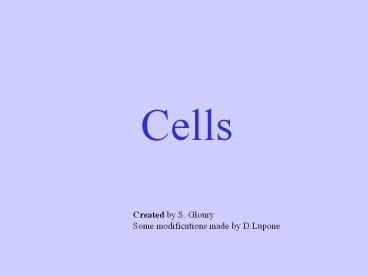Cells PowerPoint PPT Presentation
1 / 27
Title: Cells
1
Cells
Created by S. Gloury Some modifications made by
D.Lupone
2
You have trillions of cells in your body!
Fat Cells to store excess energy
3
1
Red blood cells to carry oxygen around the
body And White blood cells to fight infections
Here are some examples of cells in your body. Can
you guess what they are and what they do?
Muscle cells for movement
4
Nerve cells send electrical signals so your brain
can communicate with the rest of the cells in
your body
2
Bone cells produce calcium carbonate to support
the body
5
3
Cells
- Living things are called organisms.
- Organisms are made up of one or more cells
- In living systems cells can be divided into two
basic types - Prokaryotes
- Eukaryotes
4
Prokaryotic Cells
- What Does Prokaryotic Mean?
- (Pro Before)
- (karyopsis the kernel of a nut)
- (literally means without a nucleus)
- These are very small cells that lack membrane
bound organelles
5
A Prokaryotic Cell
6
Eukaryotic Cells
- What does eukaryotic mean?
- (eu with)
- (karyopsis the kernel of a nut)
- (literally means with a nucleus)
- These cells possess membrane bound organelles
7
Eukaryotic Cell Structure
8
A plant cell
9
ORGANELLES
Distinct structures in cells. The organelles are
surrounded by a fluid known as the cytosol.
Cytoplasm refers to the cytosol and the
organelles of a cell. Examples of organelles.
10
Cell Membrane
A layer on the outside of all cells that controls
what enters and leaves the cell. It is made up of
phospholipids and protein. Under a light
microscope, it appears as a single line. Under an
electron microscope, it appears as two lines.
Outside of Cell
Inside of Cell
11
Plant cells also have a cell wall surrounding the
cell membrane of each cell to provide structural
support
12
NUCLEUS
Function Controls activity of Cell. It does this
by the genes found in the nucleus. These genes
typically produce proteins.
13
Mitochondrion
Function Provides cell with energy in the form
of ATP. Able to be seen under a light microscope
but not clearly
14
Chloroplast
Only found in plant cells and some unicellular
organisms. Chloroplasts contain the pigment,
chlorophyll, that is necessary for
photosynthesis Photosynthesis is the process
whereby green plants manufacture their own food
using light as an energy source
15
One chloroplast as seen under an electron
microscope
16
Chloroplasts under a light microscope
17
Vacuoles
These are large fluid filled regions in cells.
They may store water, pigments or food. In plant
cells, they are typically very large and help
regulate fluid levels in the cell.
Cell from a red onion showing a vacuole
containing a red pigment
18
How do we interpret this?
Is the nucleus in the vacuole??
No
19
Other Vacuoles
Where is the vacuole here??
20
Contractile Vacuole from Paramecium a single
celled organism found in freshwater. The vacuole
pumps water out of the cell that enters by
osmosis.
Contractile Vacuole
21
Golgi Apparatus (Body)
This is an organelle that modifies and stores
proteins prior to secretion from the cell. Not
readily seen using a light microscope. Picture
show a Golgi body as seen under an electron
microscope.
22
Endoplasmic Reticulum (ER)
This is a network of membranes that provides
transport for substances, such as proteins that
are made in the cell. Not seen using a light
microscope. What does endoplasmic reticulum
literally mean?
Endo inside Plasmic cytoplasm Reticulum network
Endoplasmic reticulum
What is this? Ans Mitochondrion
23
ER another view
24
Ribosomes
These are small organelles that are the site
where proteins are made. They are often attached
to the ER or they may be free. ER that has
ribosomes attached is called rough ER. ER that
does not have ribosomes attached is called
ER.
25
Rough Endoplasmic Reticulum
26
Lets go back to a cell diagram!
27
(No Transcript)

